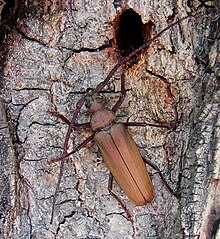
The Asian long-horned beetle, also known as the starry sky, sky beetle, or ALB, is native to the Korean Peninsula, northern and southern China, and disputably in northern Japan. This species has now been accidentally introduced into the eastern United States, where it was first discovered in 1996, as well as Canada, and several countries in Europe, including Austria, France, Germany, Italy and UK.

The longhorn beetles (Cerambycidae), also known as long-horned or longicorns, are a large family of beetles, with over 35,000 species described.
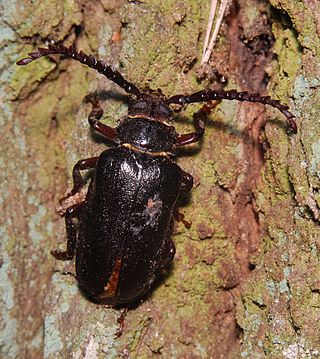
Prionus coriarius is a species of longhorn beetle.

The Rosalia longicorn or Alpine longhorn beetle, is a large longicorn that is distinguished by its distinctive markings.
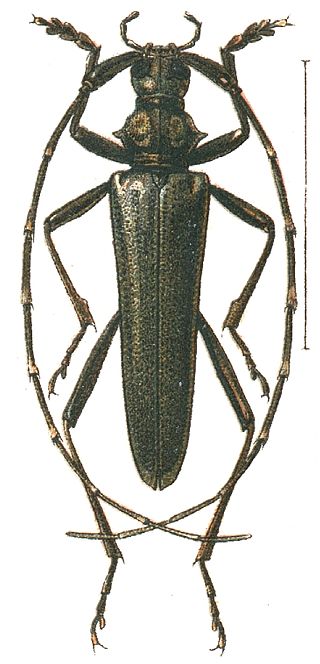
The Disteniidae are a small family of beetles in the superfamily Chrysomeloidea, traditionally treated as a group within the Cerambycidae.
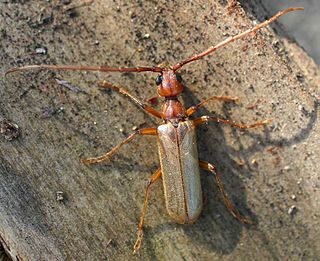
The Vesperidae are a small family of beetles, normally classified within the family Cerambycidae, of heterogeneous aspect but all characterised by larval stages related to roots of herbaceous plants or trees

Callipogon relictus is a species of longhorn beetle which is mostly found in Korea, but also in China and southern part of Russian Far East. It inhabits mixed and deciduous forests. The population of Callipogon relictus is decreasing due to deforestation and uncontrolled collection, and therefore the species are listed in the Russian Red Book.
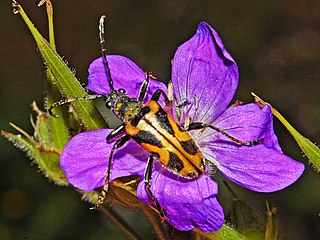
Brachyta interrogationis is the species of the Lepturinae subfamily in long-horned beetle family. This species was described in 1758 by Carl Linnaeus in the 10th edition of Systema Naturae under the name Leptura interrogationis.

Dinoptera collaris is the species of the Lepturinae subfamily in long-horned beetle family.

Pachyta quadrimaculata is a species of the Lepturinae subfamily in long-horned beetle family.

Clytus rhamni is a species of round-necked longhorns belonging to the family Cerambycidae, subfamily Cerambycinae.
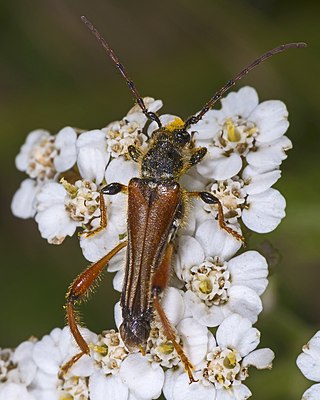
Stenopterus rufus is a beetle species of round-necked longhorns belonging to the family Cerambycidae, subfamily Cerambycinae.

Stenurella melanura is a flower longhorn beetle species of the family Cerambycidae, subfamily Lepturinae.

Stenurella bifasciata is a species of beetle in the family Cerambycidae.

Pogonocherus hispidulus, the greater thorn-tipped longhorn beetle, is a species of flat-faced longhorns beetle in the family Cerambycidae.

Hemadius is a monotypic genus of longhorn beetles, containing the species Hemadius oenochrous in the tribe Cerambycini and previously placed in the genus Neocerambyx. It is native to Asia, where it occurs in China, Vietnam, Laos, and Taiwan. It is known commonly as the cherry tree longhorned beetle and Wushe blood-spotted longhorned beetle.

Chlorophorus varius, the grape wood borer, is a species of beetle in the family Cerambycidae.

Oxymirus is the genus of the Lepturinae subfamily in long-horned beetle family.

Grammoptera ruficornis is a species of beetle in family Cerambycidae.
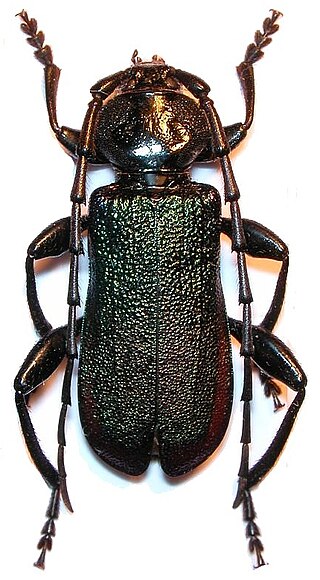
Ropalopus insubricus is a rare species of European long-horned beetle in the family Cerambycidae. It was first documented by Ernst Friedrich Germar in 1824 and first assessed for the IUCN Red List in 2009. The species is quite rare in Europe and is classified as Near Threatened.
